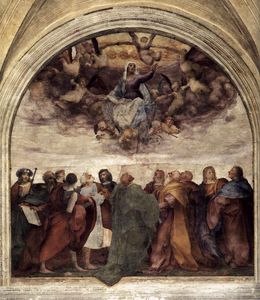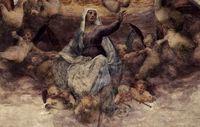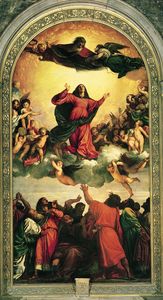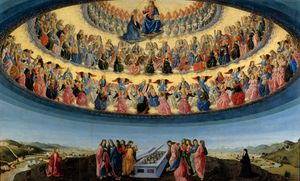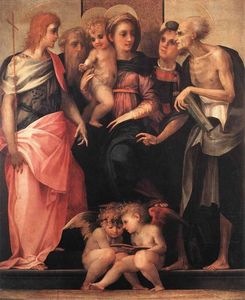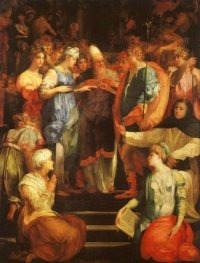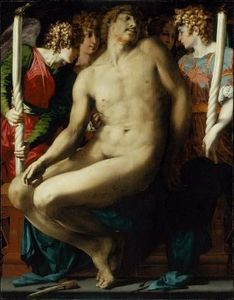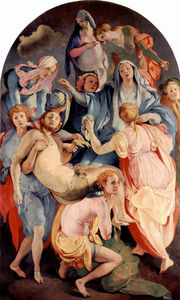The Assumption of the Virgin
- Date of Creation:
- 1517
- Height (cm):
- 395.00
- Length (cm):
- 385.00
- Support:
- Other
- Subject:
- Scenery
- Art Movement:
- Mannerism
- Created by:
- Current Location:
- Florence, Italy
- Displayed at:
- Santissima Annunziata
- Owner:
- Santissima Annunziata
- The Assumption of the Virgin Page's Content
- Story / Theme
- Analysis
- Related Paintings
- Artist
- Art Period
- Bibliography
The Assumption of the Virgin Story / Theme
This fresco depicts the assumpti&ogravzzz;n of the Virgin Mary into heaven. According to the Catholic Church, she travels to heaven with body and soul united, having been given this gift by God and fulfilling the promise of Jesus. Mary, "having completed the course of her earthly life, was assumed body and soul into heavenly glory."
Debate has persisted over the years in the Catholic Church regarding whether or not Mary actually experienced death before being assumed into heaven. This debate has led to controversy surrounding the exact artistic depiction of her the death.
The moment of Assumption itself however has always been an extremely popular topic, particularly during the Renaissance.
Artists such as Michelangelo helped form the realism that was apparent in this composition of Fiorentino's. In addition, one can see the influence of Andrea del Sarto, his mentor at the time of this painting, who utilized a similar color palette and compositional sense, though Fiorentino of course took it to more unnatural and stylized extremes.
Fiorentino, in his rejection of Renaissance ideals of harmony and typical standards of beauty, was trying to create a new way of looking at art.
He was interested more in the stylized possibilities of composition that forced the viewer to think in a more sophisticated manner, and focused on the raw emotion that could be achieved in this way.
The Assumption of the Virgin Analysis
The Assumption of the Virgin was Fiorentino's first major work and was commissioned for the monks at the Basilica of the Santissima Annunziata in Florence. This Assumption piece was a complete departure from Renaissance works that had been popular up until this time.
Composition:
The scene is split into two clear halves - the upper and lower sections divided by a swathe of gray space. The figures in the lower half are posed stiffly, all sightlines directed upwards towards the upper center point of the painting in which the Virgin Mary resides in her ascension to heaven.
The upper half of the painting is also focused around Mary, surrounded by angels and frothy swirls of movement that lends the illusion of upward ascension.
Perspective:
The chief aspect of this painting that was original at the time is the angularity of the figures which was a change from the hyperrealism of artists such as Michelangelo who believed in sculpted muscles and perfect anatomy.
The characters in the foreground are posed in stiff, somewhat unnatural positions typical of early Mannerism. Fiorentino's trademark during this time is capturing figures in a freeze-frame moment, so while appearing completely stiff there is the implication of activity.
Color palette:
The color scheme also varies from other versions of The Assumption of the Virgin. The tones are muted, dark, dingy and displeasing to the eye. Mary is encircled in darkness from above, her face in shadow rather than illuminated.
The Assumption of the Virgin Related Paintings
The Assumption of the Virgin Artist
The Assumption of the Virgin was the first major work created by Rosso Fiorentino during his formative years in Andrea Del Sarto's workshop. It made a bold statement at the time and marked the arrival of not only a brash new talent but a new movement, Mannerism.
Fiorentino was an artist with a completely unique way of seeing the world and his talent and foresight was undeniable.
For a contemporary audience used to the harmonious works of the Renaissance, however, Fioretino's The Assumption of the Virgin was not particularly well received. It was criticized for its odd use of perspective, displeasing aspects and psychologically distressing use of clashing colors.
The friars of the Basilica of the Santissima Annunziata were apparently so unhappy with the work that they asked Andrea del Sarto to repaint it.
Although Fiorentino he was derided by art critics for centuries, he has in modern years finally garnered the accolades he deserves along with the recognition as a rebel before his time.
The artist was unafraid to take conventions established by the Renaissance and turn them upside down, linking him with maverick talents of the modern era, from Surrealists to Abstract Expressionists.
The Assumption of the Virgin Art Period
After the idealism and perfectionism of the Renaissance, artists were eager to branch out and stretch the forms of artistic license during a turbulent time in Italy's history. The Assumption of the Virgin is a prime example of this new form of artistic expansion, which was to be called Mannerism.
Mannerism was a period of European art history that followed closely on the heels of the Renaissance movement. While some critics consider Mannerism as part of the Late Renaissance, others classify this as a distinct period occurring between 1520 and 1600 that represented a break from many of the artistic values of the Renaissance, as naturalism gave way to the surreal.
Noted for its sophisticated, intellectual, and artificial qualities, The Assumption of the Virgin fits right into the Mannerist mold and was influential for artists up until the late 16th century when the Baroque movement took hold.
The perception of not only Rosso Fiorentino but other Mannerists that followed, has fluctuated over the centuries, and only relatively recently have they been seen in a positive light. Fiorentino in particular was criticized for the contorted poses of his figures, as well as the fact that they often appeared somewhat thin, haggard, or skeletal.
Fortunately, in the 1950s art critics and historians started to see the Mannerists, including Fiorentino, in a different light. In fact, they did an about face in their stance on the movement, praising Mannerism for the traits they had previously counted as disabilities.
Fiorentino, with his distorted use of space and elongated figures, desire to shock and rebel against the accepted standards of the day, seems to have more in common with Modern artists than the Renaissance artists of the time.
The Assumption of the Virgin Bibliography
To find out more about Rosso Fiorentino and the Mannerist era please choose from the following recommended sources.
• Carlo, Falciani. Il Rosso Fiorentino. Olschki, 1996
• Carroll, Eugene A. & Fiorentino, Rosso. Rosso Fiorentino: Drawings, Prints, and Decorative Arts. National Gallery of Art, 1987
• Franklin, David. Rosso in Italy: Italian Career of Rosso Fiorentino. Yale University Press, 1994
• Letta, Elisabetta M. Pontormo and Rosso Fiorentino. Scala Riverside, 2001
• Natali, Antonio. Rosso Fiorentino. Silvana, 2007
• Vasari, Giorgio. Lives of the Artists: A Selection. Penguin Classics, 1987

